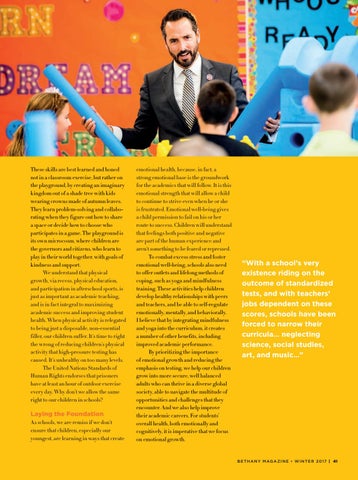“Recess lets children actively develop 21st century skills…communication, critical thinking, collaboration, and creativity…by creating an imaginary kingdom out of a shade tree with kids wearing crowns made of autumn leaves.”
These skills are best learned and honed not in a classroom exercise, but rather on the playground, by creating an imaginary kingdom out of a shade tree with kids wearing crowns made of autumn leaves. They learn problem-solving and collaborating when they figure out how to share a space or decide how to choose who participates in a game. The playground is its own microcosm, where children are the governors and citizens, who learn to play in their world together, with goals of kindness and support. We understand that physical growth, via recess, physical education, and participation in afterschool sports, is just as important as academic teaching, and is in fact integral to maximizing academic success and improving student health. When physical activity is relegated to being just a disposable, non-essential filler, our children suffer. It’s time to right the wrong of reducing children’s physical activity that high-pressure testing has caused. It’s unhealthy on too many levels. The United Nations Standards of Human Rights endorses that prisoners have at least an hour of outdoor exercise every day. Why don’t we allow the same right to our children in schools?
Laying the Foundation As schools, we are remiss if we don’t ensure that children, especially our youngest, are learning in ways that create
emotional health, because, in fact, a strong emotional base is the groundwork for the academics that will follow. It is this emotional strength that will allow a child to continue to strive even when he or she is frustrated. Emotional well-being gives a child permission to fail on his or her route to success. Children will understand that feelings both positive and negative are part of the human experience and aren’t something to be feared or repressed. To combat excess stress and foster emotional well-being, schools also need to offer outlets and lifelong methods of coping, such as yoga and mindfulness training. These activities help children develop healthy relationships with peers and teachers, and be able to self-regulate emotionally, mentally, and behaviorally. I believe that by integrating mindfulness and yoga into the curriculum, it creates a number of other benefits, including improved academic performance. By prioritizing the importance of emotional growth and reducing the emphasis on testing, we help our children grow into more secure, well balanced adults who can thrive in a diverse global society, able to navigate the multitude of opportunities and challenges that they encounter. And we also help improve their academic careers. For students’ overall health, both emotionally and cognitively, it is imperative that we focus on emotional growth.
“With a school’s very existence riding on the outcome of standardized tests, and with teachers’ jobs dependent on these scores, schools have been forced to narrow their curricula… neglecting science, social studies, art, and music…”
B E T H A N Y M AG A Z I N E • W I N T E R 2 0 1 7 | 41
